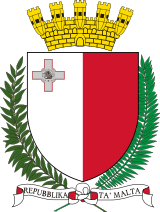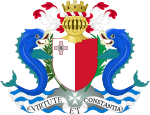- Maltese heraldry
-
The Coat of arms of Malta is the national emblem of the country of Malta.
The present coat of arms is described by the Emblem and Public Seal of Malta Act of 1988 as a shield showing an heraldic representation of the national flag of Malta; above the shield a mural crown in gold with a sally port and five turrets representing the fortifications of Malta and denoting a city-state;[1] and around the shield a wreath of two branches: the dexter of Olive, the sinister of Palm, symbols of peace and traditionally associated with Malta, all in their proper colours, tied at base with a white ribbon, backed red and upon which are written the words Repubblika ta' Malta (“Republic of Malta” in Maltese) in capital letters in black.
The national coat of arms also appears on the flag of the President of Malta, as well as on the 10c, 20c and 50c Maltese euro coins.
The coat of arms of Malta also appears on the obverse of the Maltese euro commemorative coins, minted in 2008 and 2009 in both silver and gold collectors' editions.
Contents
Coat of arms used between 1975 and 1988
This[clarification needed] coat of arms was adopted on the 11 July 1975, a year after Malta became a republic. It showed a coastal scene with the rising sun, a traditional Maltese boat (the 'Luzzu'), a shovel and a pitchfork, and an Opuntia. All of these symbols are somewhat connected to Malta. Underneath the image the then new name of the state "Repubblika Ta' Malta" (Republic of Malta) was written.
This coat of arms could be still seen on a number of coins which were still in circulation until 1 January 2008 when Malta changed its currency to the euro .
Coat of arms used between 1964 and 1975
This coat of arms depicts two dolphins which support a blazon of the Maltese flag, one with a palm branch and the other with an olive twig representing Victory and Peace respectively. Above is a crown shaped like a fort with five octagonal turrets surmounts a helmet, with red and white ribbons. Below are blue waves representing the surrounding Mediterranean Sea, the Maltese eight-pointed Cross representing the connection with the Order of St. John, and the motto Virtute et Constantia (by Valour and Firmness) on a ribbon. Nowadays, this motto is used by the National Order of Merit.
Coats of arms of cities
Il-Belt Valletta
These are the arms of Grand Master Jean Parisot de la Valette, founder of the city, at least in part, because he adopted several other arms that were included by his titles.[2]
L-Imdina
Per pale Argent and Gules. These arms may have come from Count Roger Hauteville, as did the national flag.[3]
Il-Birgu
Gules a hand couped proper clad Sable holding a sword erect Argent surrounded by a wreath Vert.[4]
References
- ^ [1]
- ^ Valetta on Heraldry of the World. Accessed 2009-02-24.
- ^ City of Mdina on Flags of the World. Accessed 2009-02-04.
- ^ City of Birgu on Flags of the World. Accessed 2009-02-04.
Heraldry by country Albania • Andorra • Armenia • Australia • Austria • Azerbaijan • Belarus • Belgium • Bosnia and Herzegovina • Brazil • Bulgaria • Canada • Croatia • Cyprus • Czech Republic • Denmark • Estonia • Finland • France • Frisia • Georgia • Germany • Greece • Hungary • Iceland • Ireland • Italy • Japan • Kazakhstan • Latvia • Liechtenstein • Lithuania • Luxembourg • Republic of Macedonia • Malta • Mexico • Moldova • Monaco • Montenegro • Netherlands • Norway • Poland • Portugal • Romania • Russia • San Marino • Serbia • Slovakia • Slovenia • South Africa • Spain • Sweden • Switzerland • Turkey • Ukraine • United Kingdom (England • Scotland • Wales) • United States • Vatican City
Categories:- Heraldry by country
Wikimedia Foundation. 2010.


